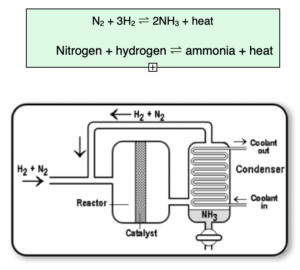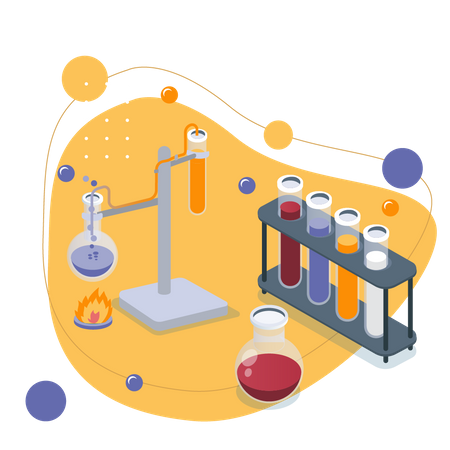Haber Process (GCSE Chemistry)
Haber Process
Components of the Haber Process
Producing Nitrogen Based Fertilisers
In industry, the Haber process is used to manufacture ammonia. The ammonia can then be used to form nitrogen-based fertilisers.
Raw Materials
- Raw materials are required. As with any reaction, raw materials are required to begin the Haber process. These raw materials will react to form ammonia.
- Nitrogen and hydrogen are raw materials. In forming ammonia, the raw materials used in the Haber process are nitrogen and hydrogen.
- Air is a source of nitrogen. Nitrogen is very abundant gas in air. Therefore, air is the primary source for nitrogen in the Haber process. Air is fractionally distilled to produce nitrogen as the gases (nitrogen and oxygen) in air have different boiling points and condense at different temperatures.
- Methane is a source of hydrogen. When methane reacts with steam, carbon dioxide and hydrogen are formed. This is a source for hydrogen in the Haber process.
methane + steam → carbon dioxide + hydrogen
The Haber Process
Method
For exams, you’ll be expected to learn to Haber process. In this section, we’ll break the process down into simple steps that you can memorise.
- Gases pass over a catalyst. To start off the Haber process, both nitrogen gas and hydrogen gas are passed over an iron catalyst.
- A high temperature and pressure are used. When the gases pass over the catalyst, they are under a high temperature of 450⁰C and a high pressure of 200 atmospheres.
- Ammonia is produced. As the nitrogen and hydrogen react together, ammonia will be produced. This is the product of the Haber process.
- Hydrogen and nitrogen are re-formed. The Haber process is a reversible reaction. The ammonia can re-form hydrogen and nitrogen again.
- Liquefied ammonia is removed. As the ammonia is formed, it is cooled and condenses first, as it has a higher boiling point compared to hydrogen and nitrogen. Ammonia is removed from the column.The hydrogen and nitrogen are recycled into the reactor to react to form more ammonia, which can go on to make fertiliser.

The Haber Process is a chemical reaction that is used to produce ammonia (NH3) from nitrogen (N2) and hydrogen (H2) gases. This reaction was developed by the German chemist Fritz Haber in the early 20th century and is now one of the most important industrial processes in the world.
The Haber Process is important because it allows us to produce large amounts of ammonia, which can be used as a fertilizer to help grow crops and feed the world’s growing population. Ammonia is also used as a starting material in the production of many other chemicals, including nitric acid and various plastics.
The reactants in the Haber Process are nitrogen (N2) and hydrogen (H2) gases. These gases are mixed together and then subjected to high pressure and high temperature in the presence of a catalyst to produce ammonia (NH3).
A catalyst is a substance that speeds up a chemical reaction without being used up or changed in the process. In the Haber Process, an iron catalyst is used to increase the rate of the reaction and produce more ammonia.
The Haber Process works by bringing the nitrogen and hydrogen gases into close contact with each other, and then applying high pressure and high temperature in the presence of an iron catalyst. This causes the nitrogen and hydrogen to react and form ammonia.
The conditions used in the Haber Process are high pressure (around 200 atmospheres) and high temperature (around 450°C). These conditions are necessary to make the reaction happen quickly and produce enough ammonia to be useful.
The products of the Haber Process are ammonia (NH3) and nitrogen (N2). The nitrogen gas is not used up in the reaction and is simply released into the atmosphere.
The Haber Process is used in agriculture to produce ammonia fertilizers, which can be applied to crops to help them grow. Ammonia is an important source of nitrogen, which is one of the key elements needed for plant growth.
Some limitations of the Haber Process include the high energy and raw material costs, as well as the release of large amounts of nitrogen gas into the atmosphere. Additionally, the process requires specialized equipment and highly trained operators, which can make it expensive to implement on a large scale.






Still got a question? Leave a comment
Leave a comment